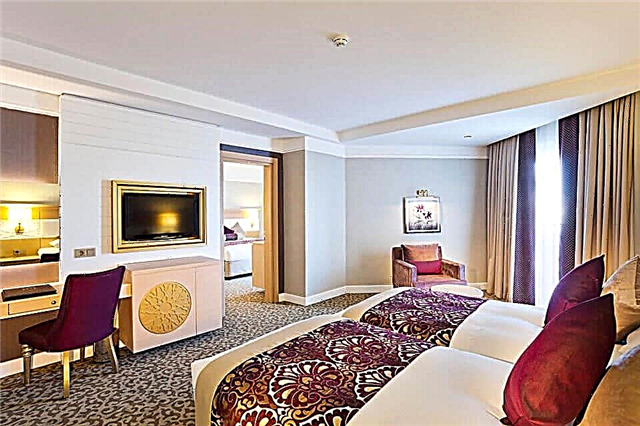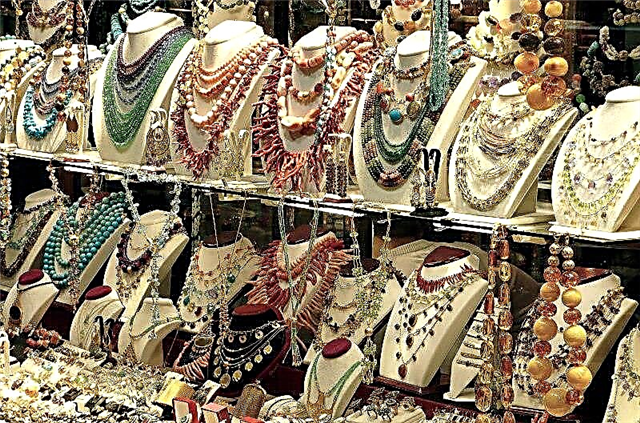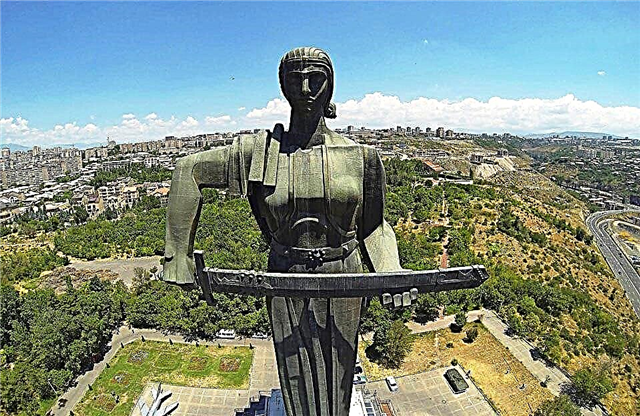The legendary city, which, according to generally accepted statistics, was born in 782 BC. NS. was founded by the king of the ancient state of Urartu Argishti I as a fortress of Erebuni. According to legend, 6 thousand prisoners worked on the construction of fortifications, the remains of some of them can be seen today. The long-suffering and courageous history of the Armenian people is reflected in the majestic monuments of architecture and art of Yerevan. The city of gray and pink tuff conquers with its beauty once and for all. It will take a lot of time to see all its sights, but we will tell you what to see in Yerevan in one day on our own.
Complex "Cascade"

One of the grandiose monumental objects that has become a symbol - the "Cascade" complex is of great interest to tourists, despite the complete completion of its construction. The project of this truly unique building was developed at the beginning of the last century by the academician of architecture Tamanyan, whose name is engraved in the sculpture and the name of the street.
In fact, this is a majestic building, on both sides of which steps go down to the square, decorated with bright flower beds and picturesque fountains. A 50-meter obelisk "Revived Armenia" is erected over the Cascade. Construction, interrupted by the tragic conflict in Karabakh, continues now. Inside the premises, it was decided to open exhibition pavilions, cafes and restaurants. But even in an unfinished state, a visit to the "Cascade" will become an unforgettable event.
Matenadaran Museum

Not every capital city owns such a museum as Matenadaran, which owns priceless rarities in the form of ancient manuscripts (17 thousand handwritten texts and 13 thousand various documents). Until 1920, the rarities were kept in the Echmiadzin Monastery, and in 1959 they were transported to the opened museum, which became, in essence, the Research Institute of Antiquity Works. The first printed books in Armenian (15-18 centuries), multilingual manuscripts (2 thousand copies), handwritten texts in Armenian (13 thousand), including works on history, geography, philosophy, medicine, found their place here.
In the museum-institute, you can get acquainted with the works of ancient scientists from other countries, translated into Armenian, see samples of the writing of the state of Urartu. Matenadaran, whose name is translated as "book depository", is of great importance in the study of the cultural and historical heritage of Armenia, Transcaucasia, the peoples of the Near and Middle East. The view of the museum building, created in the style of Armenian architecture of the 12-13th centuries, as well as the sculptural monuments to the founder of Armenian writing M. Mashtots and other prominent figures of science and culture of the past, are impressive.
Tsitsernakaberd memorial

Probably, every conscious inhabitant of the planet knows about the terrible fact of the unprecedented genocide of the Armenian people in 1915, which shook the whole world with the cruelty of the Turks. The Tsitsernakaberd Memorial, erected on the top of a hill in the park of the same name, has become a symbol of the mournful memory of the unprecedented tragedy. The monument to the innocent victims consists of a majestic circular mausoleum, divided into 12 pylons, each of which denotes a province of modern Turkey. The eternal flame always burns inside the structure.
The top of the Mausoleum is crowned with a 40-meter peaked obelisk, divided into 2 parts, symbolizing the division of the country into Western and Eastern Armenia. The obelisk is a sign confirming the revival of the Armenians. A mourning alley of firs planted by representatives of politics and culture from different countries who come here on official visits has been laid to the Memorial. Tsitsenrnakabed is a place of pilgrimage not only for Armenians, but also for people of various nationalities.
Monument "Mother Armenia"

One of the sacred objects is the Mother Armenia Memorial, which immortalized the memory of the military exploits of the Armenian people and became a symbol of their courage and fortitude. The 54-meter monument rises on a hill in Victory Park in a straight line with the city's central avenue named after M. Mashtots. Until 1962, a sculpture of Stalin stood on a powerful pedestal faced with black tuff. After its dismantling (1967), a symbolic statue "Mother Armenia" was installed in its place.
The majestic and solemn sculpture in the form of a slender figure of a woman, with a sword in her hands, which she hides in a sheath, has become a symbol of hope for peace. But at the feet of the "mother" lies a shield as a sign of readiness to defend the country in a moment of danger. According to the architect Harutyunyan's idea, the expressive statue is made of hammered copper, which guarantees the noble longevity of the monument. Today, various weapons are installed around the Monument, and in front of it on the grave of the unknown soldier the Eternal Flame is burning and the Museum of the Ministry of Defense of Armenia is open.
Armenian Genocide Museum

The Museum of Genocide was opened in the district of Tsitsernakaberd Memorial. A 2-level building has been created underground, the expositions of which shed light on the inhuman history of the Armenian genocide by the Turkish authorities. The museum, located underground, personifies the tomb, and the inner rooms of the 2nd level in the form of a circle symbolize the circles of hell. It is impossible to consider the mournful exhibits of the terrible museum, illustrating the inhuman suffering that fell to the lot of the unfortunate victims of the Ottoman monsters, without a mental shudder and "goosebumps".
3 halls of the upper tier introduce the reasons and preparation of the genocide through original photos and documents. Here you can get acquainted with the materials on the condemnation of the Turkish atrocities by political and public international organizations. The 4th hall, located in the open air, is filled with 12 granite blocks, on which the words of condemnation of the genocide from the statements of famous personalities of the world are inscribed. The lower tier of the Museum is a kind of archive of documentary evidence of the tragedy, a library, study rooms, an assembly hall.
Blue Mosque

It is impossible to ignore the unconventional for Armenians building of the Persian mosque, popularly nicknamed Blue for the color of its dome and quotes from the Koran written on its walls in blue paint. The unusually beautiful structure embodies the history of Armenia, its relationship with Iran (Persia). Islamic Church 18th century survived in the Soviet years, thanks to the initiative of the Armenian poet E. Charents, who proposed to make the mosque a neutral object by organizing a history museum in it.
Now this beautiful architectural monument is very popular among Yerevan residents and tourists and plays the role of a cultural center, being a symbol of friendly relations between Christians and Muslims. The legal rights to the mosque will belong to the Iranian Embassy in Armenia for 99 years by the decision of the Armenian government. The oriental beauty of the Blue Mosque's decoration continues to delight the eyes of all visitors.
Erebuni fortress

The ruins of the ancient fortress-city of Erebuni, which in prehistoric times served as the residence of King Argishti I, today is an open-air museum, the foremother of Yerevan. Acquaintance with him gives a complete picture of the level of development of society on the territory of Armenia BC. As a result of archaeological excavations, the date of the foundation of the fortress (782) is precisely established, as evidenced by the discovered cuneiform, which was, in fact, the official document of the "birth" of Erebuni. A visit to this amazing object is a fascinating immersion in architecture, painting, culture and life of the inhabitants of Urartu.
Here are the remains of a luxurious royal palace, temples, various halls with traces of rich design. The model of the fortress created by scientists allows you to thoroughly determine the layout of all fortifications and restore their original appearance.Looking at the mighty walls made of clay bricks, at the intricate paintings with complex ornaments on the surviving frescoes, it is hard to believe that all this was created almost 3 thousand years ago. Excavations continue and reveal for us new secrets of antiquity, striking the imagination with virtuosity and technique of work execution.
Republic Square

The main square of the city, which has a rather unusual shape of interconnected oval and trapezoid, Republic Square is the focus of magnificent buildings along its perimeter, each of which is a real work of art of architecture. Probably everyone knows that the main building materials are natural white, pink, black tuff and basalt. It is from these beautiful rocks that the surrounding squares are built. Republics 5 buildings: House of Ministries, Government House, Central Post Office, Marriott Armenia Hotel and Historical Museum of Armenia.
One cannot but admire the amazing arches, columns, graceful carved ornamental decorations in the national style on their facades. The gray basalt plinth emphasizes the captivating harmony of the multicolored tuff, making the buildings incredibly beautiful. The author of the project, architect Tamanyan, has devoted more than 20 years to the design of this truly sacred place in the city. Now pl. The Republic is one of the most beautiful squares in the world, where 2 eras are combined - bright modernity and an unforgettable past.
National History Museum of Armenia

Place of honor on pl. The republic belongs to the State Museum of the History of Armenia, located in half of one of the monumental buildings (the second half is the Picture Gallery). Founded back in 1921, the Museum constantly replenishes its collections with new exhibits and can rightfully be proud of unique artifacts (400 thousand items) illustrating the most different periods of the country's historical development. 5 thematic departments: archeology, ethnography, numismatics, architectural-historical and modern history - contain extensive visual and informational material that gives a complete picture of the stages of the formation of the state.
The richest collection of the archaeological department is represented by bronze, ceramic, gold, and silver items produced by BC. The exposition of finds during the excavations of Urartu - various types of vessels, containers for storing wine and grain, samples of weapons and cuneiform texts on stone, sculptures from bronze and even military equipment of King Argishti. Each museum department has valuable rarities in its arsenal, which are extremely interesting to see.
Singing Fountains

Undoubted decoration of pl. Republics - an organic synthesis of jets of water, light and music "Singing Fountains" fascinates with its beauty all those who (especially in the evening hours) are nearby. The appearance here of this miracle of engineering thought is the merit of talented enthusiastic designers, who for the first time in the USSR created a "singing fountain" based on the German model more than 50 years ago. Several years ago, the fountains underwent restoration and modernization, and became even more beautiful.
Water jets, smoothly swaying, descending and ascending to the beat of different genres of music and changing colors of illumination, create a truly magical, enchanting sight. Every evening during the fountain season, crowds of tourists and locals gather around them, enjoying a truly magnetic contemplation. The background is very well chosen by the creators of the Singing Fountains - the majestic building of the National Historical Museum.
Charles Aznavour square

The name of the famous French chansonnier with Armenian roots Charles Aznavour was given to the square, which appeared in Yerevan a long time ago according to Tamanyan's plan. Nowadays, the main cultural institutions of the capital are located along its perimeter: the Moscow cinema theater, the Drama theater. Stanislavsky, House of Artists. Each of them occupies a magnificent building in the style of national architecture, which is a true decoration of the square. Its center is marked by a picturesque fountain "Signs of the Zodiac" (1983).
The expressive symbolic sculptures (12) framing the bowl look very picturesque. The name of the beloved chansonnier Aznavour was given to the square in 2001, when he came to celebrate the 10th anniversary of the republic's independence. It even has its own "Avenue of Stars", founded in 2010. Famous filmmakers of Armenia were the first to be featured on it. A star with the name of Aznavour was opened in his presence in 2013 after the restoration of the square. Citizens and tourists love to visit this interesting and beautiful place.
Brandy factory "Ararat"

The famous symbol of Armenia - "Ararat" cognac, which is not inferior in popularity to world brands of this noble drink, has been produced since 1887. Over the long history of its existence, the manufacturing plant has been repeatedly awarded medals at international cognac exhibitions. Today, the elite enterprise is located in a beautiful monumental building, equipped with high-tech equipment, and is part of the well-known French company Pernod Ricard Group.
The products of the Ararat brandy factory are in high demand among connoisseurs and lovers of the legendary drink. Visiting the factory, tourists have the opportunity to get acquainted with its rich history, visually see the process of cognac production, taste several types of drink. Opposite the factory is the Noy wine and brandy factory, the museum of which clearly presents the history of the development of the production of Armenian brandy. In a small company shop at the factory you can buy any sort of Ararat brandy in a beautiful bottle.
Zoo

There is an object in the capital of Armenia that the city can deservedly be proud of due to its unique organization. This is a zoo, created in the pre-war (1941) year in the northeastern side and occupying 25 hectares of the picturesque territory of the zoo. The uniqueness of the organization of the maintenance of the local fauna is the maximum approximation of the way of life of animals and birds to the wild habitat. It is based on the principle of "getting food", when one or another animal is forced to make movements similar to those characteristic of a free lifestyle.
For example, a bear is given ice cubes with frozen fruits and vegetables; tigers - hanging pieces of meat; other large felines "pack" food in cardboard boxes for them to work hard to find food. This makes the inhabitants of the zoo active and "cheerful", and watching their "meal" is a fascinating sight. It is especially interesting to visit the zoo on holidays, when real show performances with animation, puppet shows, performances of clowns and trainers are organized here. On the territory of the zoo there are extraordinary sculptures created by children from plastic bottles and other waste.
Lovers' park

On Marshal Baghramyan Avenue, there is a favorite place for Yerevan residents - the Lovers' Park, which received such a romantic name not so long ago (1995). The park existed here since the 18th century, surrounding the chapel and the adjacent ancient cemetery. In Soviet times, it was called the Pushkin Garden, where, according to an old tradition, couples in love came and continue to come on dates. That is why the park, whose landscape design amazes with its beauty, was officially renamed.
Cozy alleys, a charming artificial lake, picturesque ponds, a mini-waterfall, many flower lawns, ornamental shrubs, green lawns, interesting sculptures create a magnificent picture that must be admired. After a solid reconstruction (2008), a summer cafe, an amphitheater appeared here, where concerts, solemn meetings and celebrations are held. The romantic symbol of the Lovers' Park is the expressive statue of the poet-lyric poet G. Emin.
House-Museum of Sergei Parajanov

The opening of the House-Museum of the famous film director Sergei Parajanov in 1991 is an amazing fact that confirms how sacred the Armenian people honor the memory of their great brothers. Parajanov, an incredibly talented creator, a genius of art, an Armenian by nationality, who had never lived in Armenia, bequeathed all his artwork to the homeland of his ancestors. An artist, director, sculptor, musician, fighter for freedom of speech, whose name was given to one of the planets, died in Yerevan in 1990.
The museum began to be created during the life of the genius, in 1988, a terrible earthquake tragic for Armenia, therefore it was opened after the death of Parajanov. The organizers tried to truly recreate the interior of the director's Tbilisi house, to present his personal belongings. But the main exhibits of the museum are the creative works of an outstanding artist: drawings, collages, sketches for feature films, dolls, ceramics (600 items). 2 Memorial Rooms contain photos, documents, reviews from critics and contemporaries, letters and other evidence of the bright and difficult life of the greatest film and art figure.











